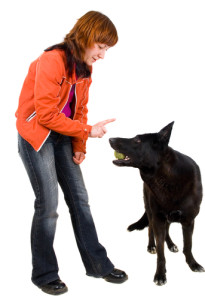What do you do when your dog makes a mistake? Your answer may be what’s slowing down your progress.
Regardless of what you are training for or the methods you use, most of us have some way that we “voice” our displeasure when our dog makes a mistake. But maybe we shouldn’t.
Related: Best Dog Training Courses You Can Online
Human Nature
It seems to be human nature. We are used to yelling at our kids and spouses, and maybe even our boss or subordinates at work. Conversely, we expect negative consequences – yelling, detention, bad grades, pay cuts, firing, divorce – if we do something wrong.
Society has survived for hundreds of years with this set-up, so it makes sense that we would include the family dog into this age-old system.
But is surviving thriving? We certainly don’t have less crime or divorce, we don’t have kids doing better in school or more people with higher-paying jobs. So while we humans get along in the system we created, we can’t exactly say it is fool-proof or even the best way to get things done.
We just can’t seem to help ourselves when it comes to pointing out mistakes, and some even seem to take pleasure in the yelling and screaming when a mistake is made. It makes them feel more powerful or maybe it releases their own pent-up frustration. After all, the dog can’t stand up for himself, so it’s easy to blame him for a missed cue. Or it could just simply be because, as humans, the word NO is one of the first ones we learn so it has a tendency to come out of our mouths…a lot.
Negative Markers

So, when our dog does make a mistake, common responses from us humans are:
- Yelling “no”
- Yelling some noise like “uh-uh”
- Shaking a can full of pennies
- Spraying them with water
- Physical correction
- Time-out in a crate
And the list goes on…
But what exactly are we doing when we give one of these negative responses to our dog for say, barking at the door?
They got attention (even negative attention is still attention – just ask the teenager that lashes out when her parents get a divorce), maybe they think we are joining in (esp. if you yell or shake a can full of pennies as they bark), or in the case of a time-out, the scary thing they were barking at was removed so they got what they wanted and thus were reinforced.
Silence
What if you said nothing – made no reaction – when your dog got something wrong? Many positive reinforcement trainers have started to drop the negative marker – to cite a universally available example, if you watch the early seasons of It’s Me or The Dog Victoria Stilwell used a negative maker – usually a loud nonsensical noise – to mark wrong behaviors. However, she drops this in later seasons.
The question is why?
Think about it from a human perspective. What is one of the top things people do when someone wrongs them? The Silent Treatment. Why? Because we all know it works. The other person will quickly try to figure out what they must do to get you to break your silence.
When you are silent in dog training, your dog will do the same thing – try to figure out what you want to get you to speak to them again.
This means that if you start staying silent when your dog is guessing wrong say for example, sitting instead of laying down, you should see him figure it out quicker than if you made a lot of noise every time he got it wrong.
Today, count how many times you say NO (or a similar negative marker) to your dog. And then pay attention to his reaction – how often does he pay attention, how often does he ignore you? Is the word really getting your dog to stop doing whatever it is that is incorrect?
NOTE: Use my trainer, Carolyn Wilki’s, “$150 rule.” If your dog is going to make $150 or more worth of damage OR is doing something harmful (eating chocolate) – they you must step in. Do not “do nothing” and let your dog harm themselves or burn down the house.
About the Author
Based in Wilsonville, Ore., animal lover Kristina N. Lotz is a Certified Professional Dog Trainer – Knowledge Assessed (CPDT-KA) and works as a full time trainer. She is the founder of, A Fairytail House, a unique all-positive all-sport dog training facility that helps rescue dogs in her area and provides free seminars and training classes for the community. In her spare time, she trains and competes in herding, agility, obedience, rally, and conformation with her Shetland Sheepdogs. She smartly married a Veterinary Technician, who helps keep the fur kids happy and healthy, and provides a quick resource for articles.
 Toledo, United States.
Toledo, United States.